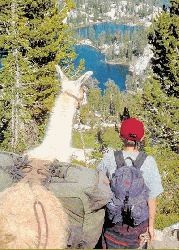Not into horses? How about a llama?
Published 12:00 am Friday, September 15, 2006

- A hiker and llama look down in Pine Lakes in the Pine Creek drainage above Cornucopia. Most clients who take a trip with Wallowa Llamas like to walk, but don't fancy carry the heavy packs required for backpacking into the Eagle Caps. (Photo by Raz Rasmussen of Wallowa Llamas).
By LISA BRITTON
Trending
Not a horse person?
Like the idea of having a four-legged mammal haul your stuff into the backcountry while you mosey along the trail?
That’s exactly why Raz Rasmussen and Steve Backstrom started their business Wallowa Llamas in Halfway back in 1985.
Trending
andquot;We were both backpackers,andquot; says Backstrom, who also owns the Hells Canyon Journal.
Llamas can carry up to 100 pounds, have padded feet that leave virtually no trace and are browsers so there’s no need to pack in special feed.
andquot;They don’t have much impact on the trails,andquot; Backstrom said.
The llamas 45 of them are kept on the acreage owned by Rasmussen and his wife, Louise.
The lure of llamas, Louise said, is that people still get to hike the trails but don’t have to suffer from heavy backpacks.
andquot;People who go with llamas want to do the walking,andquot; she said. andquot;They get to a certain age, or have children, but still want to walk.andquot;
She laughs when asked about the personalities of llamas.
andquot;They have a pretty easy temperament, but they’re definitely aloof and don’t bond with people,andquot; she said.
Rasmussen and Backstrom guide trips from April through September, and the hikes vary in length and difficulty.
They mostly cater to hikers, though sometimes hunters request a drop camp, meaning the llamas transport all the gear to a designated spot where the hunters want to search for game.
Horses and llamas on the trail
When these llama owners talk of the guided trips through the Wallowas, the first thing they mention is the food.
andquot;Gourmetandquot; is how they describe it fresh fruit and vegetables, homemade bread and desserts.
andquot;We have different menus for different length trips,andquot; Louise said.
And she rattles off such dishes as lasagna, enchiladas, guacamole, andquot;margaritas on the snowandquot; and a Thai stir fry.
andquot;Sometimes we even take cheesecake up,andquot; she said.
Louise prepares as much of the meal at home as she can, and then the guides are the cooks in camp.
But the wilderness isn’t without its setbacks, and the llamas have to interact not only with people, but the horses that plod along the same trails.
andquot;The horses can be very spooked by llamas, and that’s a problem,andquot; Louise said.
When the two types of pack strings meet on the trail, the llamas relinquish right-of-way and go off the trail downhill, she said.
Also, some horse owners have asked to borrow a couple llamas so the horses have a chance to get used to the other animals.
Llamas do spit, she said, but only at other llamas.
andquot;That’s how they communicate with each other they’re very particular about space,andquot; she said.
Though the llamas allow hikers to walk with a light load if any pack at all these trips are fairly slow, Louise said.
For a 7-mile trip, the group might leave at 11 a.m., stop for an hour-long lunch, then arrive at camp around 5 p.m.
andquot;We take breaks, let them drink water,andquot; she said. andquot;It’s actually a nice pace to go.andquot;
To learn more about the llamas, which can also be rented with a short orientation, visit the Web site at www.wallowallamas.com, or call 541/742-2961 or 541/742-4930.








